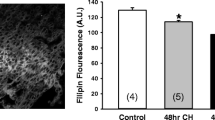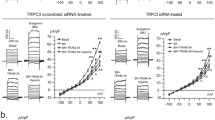Abstract
We examined the effects of acute hypoxia on vascular tone and coronary blood flow (CBF) in rabbit coronary arteries. In the pressurized arterial preparation of small arteries (<100 μm) and the Langendorff-perfused rabbit hearts, hypoxia induced coronary vasodilation and increased CBF in the presence of glibenclamide (KATP channel blocker), Rp-8-Br-PET-cGMPs [cyclic guanosine monophosphate (cGMP)-dependent protein kinase inhibitor, Rp-cGMPs], and methionyl transfer RNA synthetase (MRS) 1334 (adenosine A3 receptor inhibitor); these increases were inhibited by the inward rectifier K+ (Kir) channel inhibitor, Ba2+. These effects were blocked by the adenylyl cyclase inhibitor SQ 22536 and by the cyclic adenosine monophosphate (cAMP)-dependent protein kinase (PKA) inhibitors Rp-8-CPT-cAMPs (Rp-cAMPs) and KT 5720. However, cGMP-dependent protein kinase was not involved in the hypoxia-induced increases of the vascular diameter and CBF. In summary, our results suggest that acute hypoxia can induce the opening of Kir channels in coronary artery that has small diameter (<100 μm) by activating the cAMP and PKA signalling pathway, which could contribute to vasodilation and, therefore, increased CBF.





Similar content being viewed by others
References
Daut J, Maier-Rudolph W, von Beckerath N, Mehrke G, Gunther K, Goedel-Meinen L (1990) Hypoxic dilation of coronary arteries is mediated by ATP-sensitive potassium channels. Science 247:1341–1344
Mellemkjaer S, Nielson-Kudsk JE (1994) Glibenclamide inhibits hypoxic relaxation of isolated porcine coronary arteries under conditions of impaired glycolysis. Eur J Pharmacol 270:307–312
Vanhoutte PM, Shimokawa H (1989) Endothelium-derived relaxing factor and coronary vasospasm. Circulation 80:1–9
Nakhostine N, Lamontagne D (1993) Adenosine contributes to hypoxia-induced vasodilation through ATP-sensitive K+ channel activation. Am J Physiol 265:H1289–H1293
Nakhostine N, Lamontagne D (1994) Contribution of prostaglandins in hypoxia-induced vasodilation in isolated rabbit hearts. Relation to adenosine and KATP channels. Pflügers Arch 428:526–532
Raatikainen MJ, Peuhkurinen KJ, Hassinen IE (1994) Contribution of endothelium and cardiomyocytes to hypoxia-induced adenosine release. J Mol Cell Cardiol 26:1069–1080
Huang KT, Han TH, Hyduke DR, Vaughn MW, van Herle H, Hein TW, Zhang C, Kuo L, Liao JC (2001) Modulation of nitric oxide bioavailability by erythrocytes. Proc Natl Acad Sci USA 98:11771–11776
Dart C, Standen NB (1995) Activation of ATP-dependent K+ channels by hypoxia in smooth muscle cells isolated from the pig coronary artery. J Physiol 483:29–39
Quayle JM, McCarron JG, Brayden JE, Nelson MT (1993) Inward rectifier K+ currents in smooth muscle cells from rat resistance-sized cerebral arteries. Am J Physiol 265:C1363–C1370
Suh SH, Park SJ, Choi JY, Shim JH, Kim YC, Kim SJ, So I, Kim KW (1998) Sensitivity of rabbit cerebral artery to serotonin is increased with the moderate increase of extracellular K+. Korean J Physiol Pharmacol 2:695–703
Park WS, Han J, Kim N, Ko JH, Kim SJ, Earm YE (2005a) Activation of inward rectifier K+ channels by hypoxia in rabbit coronary arterial smooth muscle cells. Am J Physiol 289:H2461–H2467
Park WS, Han J, Kim N, Youm JB, Joo H, Kim HK, Ko JH, Earm YE (2005b) Endothelin-1 inhibits inward rectifier K+ channels in rabbit coronary arterial smooth muscle cells through protein kinase C. J Cardiovasc Pharmacol 46:681–689
Park WS, Kim N, Youm JB, Warda M, Ko JH, Kim SJ, Earm YE, Han J (2006) Angiotensin II inhibits inward rectifier K+ channels in rabbit coronary arterial smooth muscle cells through protein kinase C alpha. Biochem Biophys Res Commun 341:728–735
Park WS, Son YK, Kim N, Youm JB, Joo H, Warda M, Ko JH, Earm YE, Han J (2006) The protein kinase A inhibitor, H-89, directly inhibits KATP and Kir channels in rabbit coronary arterial smooth muscle cells. Biochem Biophys Res Commun 340:1104–1110
Knot HJ, Zimmermann PA, Nelson MT (1996) Extracellular K+-induced hyperpolarizations and dilatations of rat coronary and cerebral arteries involve inward rectifier K+ channels. J Physiol 492:419–430
Johnson TD, Marrelli SP, Steenberg ML, Childres WF, Bryan RM Jr (1998) Inward rectifier potassium channels in the rat middle cerebral artery. Am J Physiol 274:R541–R547
Son YK, Park WS, Ko JH, Han J, Kim NR, Earm YE (2005) Protein kinase A-dependent activation of inward rectifier potassium channels by adenosine in rabbit coronary smooth muscle cells. Biochem Biophys Res Commun 337:1145–1152
Jiang H, Colbran JL, Francis SH, Corbin JD (1992) Direct evidence for cross-activation of cGMP-dependent protein kinase by cAMP in pig coronary arteries. J Biol Chem 267:1015–1019
Jones CJ, Kuo L, Davis MJ, Chilian WM (1995) Regulation of coronary blood flow: coordination of heterogeneous control mechanisms in vascular microdomains. Cardiovasc Res 29:585–596
Quayle JM, Dart C, Standen NB (1996) The properties and distribution of inward rectifier potassium currents in pig coronary arterial smooth muscle. J Physiol 494:715–726
Shaul PW, Muntz KH, DeBeltz D, Buja LM (1990) Effects of prolonged hypoxia on adenylate cyclase activity and β-adrenergic receptors in pulmonary and systemic arteries of rat. Circ Res 66:1526–1534
Frisbee JC, Sylvester FA, Lombard JH (2001) High-salt diet impairs hypoxia-induced cAMP production and hyperpolarization in rat skeletal muscle arteries. Am J Physiol 281:H1808–H1815
Lincoln TM, Cornwell TL (1993) Intracellular cyclic GMP receptor proteins. FASEB J 7:328–338
Carrier GO, Fuchs LC, Winecoff AP, Giulumar AD, White RE (1997) Nitrovasodilators relax mesenteric microvessels by cGMP-induced stimulation of Ca2+-activated K+ channels. Am J Physiol 273:H76–H84
Haynes J Jr, Kithas PA, Taylor AE, Strada SJ (1991) Selective inhibition of cGMP-inhibitable cAMP phosphodiesterase decreases pulmonary vasoreactivity. Am J Physiol 261:H487–H492
Gao Y, Dhanakoti S, Tolsa JF, Raj JU (1999) Role of protein kinase G in nitric oxide- and cGMP-induced relaxation of new born ovine pulmonary veins. J Appl Physiol 87:993–998
Barman SA, Zhu S, Han G, White RE (2003) cAMP activates BKCa channels in pulmonary arterial smooth muscle via cGMP-dependent protein kinase. Am J Physiol 284:L1004–L1011
Robertson BE, Bonev AD, Nelson MT (1996) Inward rectifier K+ currents in smooth muscle cells from rat coronary arteries: block by Mg2+, Ca2+, and Ba2+. Am J Physiol 271:H696–H705
Nelson MT, Patlak JB, Worley JF, Standen NB (1990) Calcium channels, potassium channels and the voltage dependence of arterial smooth muscle tone. Am J Physiol 259:C3–C18
Acknowledgments
This work was supported by Grants R05-2003-000-00413-0, R05-2004-000-00905-0, and R01-2004-000-10045-0 of the Korea Science and Engineering Foundation, the Korea Research Foundation Grant funded by the Korean Government (MOEHRD; KRF-2002-E00076, KRF-2002-042-E00006, KRF-2003-015-E00025, KRF-2005-210-E00003 and KRF-2005-211-E00006, and KRF-2005-037-E00002).
Author information
Authors and Affiliations
Corresponding author
Rights and permissions
About this article
Cite this article
Park, W.S., Son, Y.K., Kim, N. et al. Acute hypoxia induces vasodilation and increases coronary blood flow by activating inward rectifier K+ channels. Pflugers Arch - Eur J Physiol 454, 1023–1030 (2007). https://doi.org/10.1007/s00424-007-0269-4
Received:
Accepted:
Published:
Issue Date:
DOI: https://doi.org/10.1007/s00424-007-0269-4




